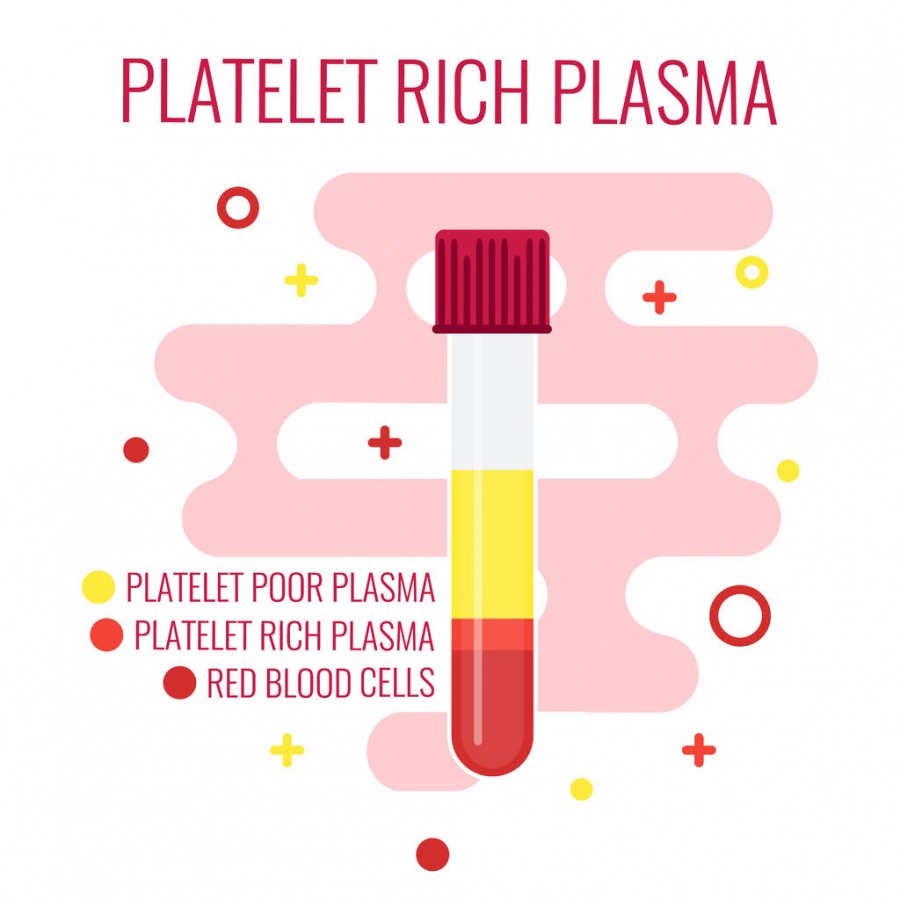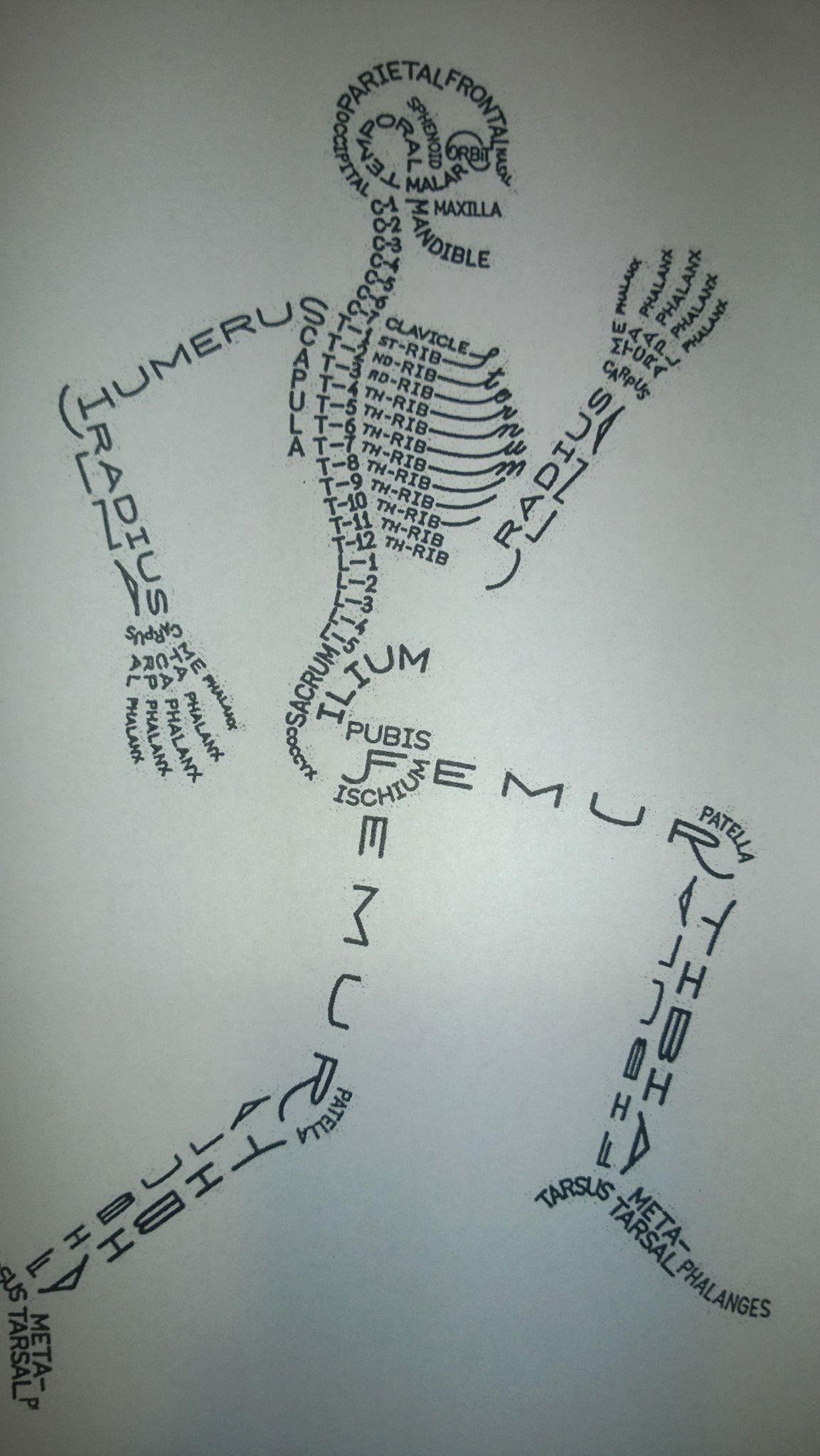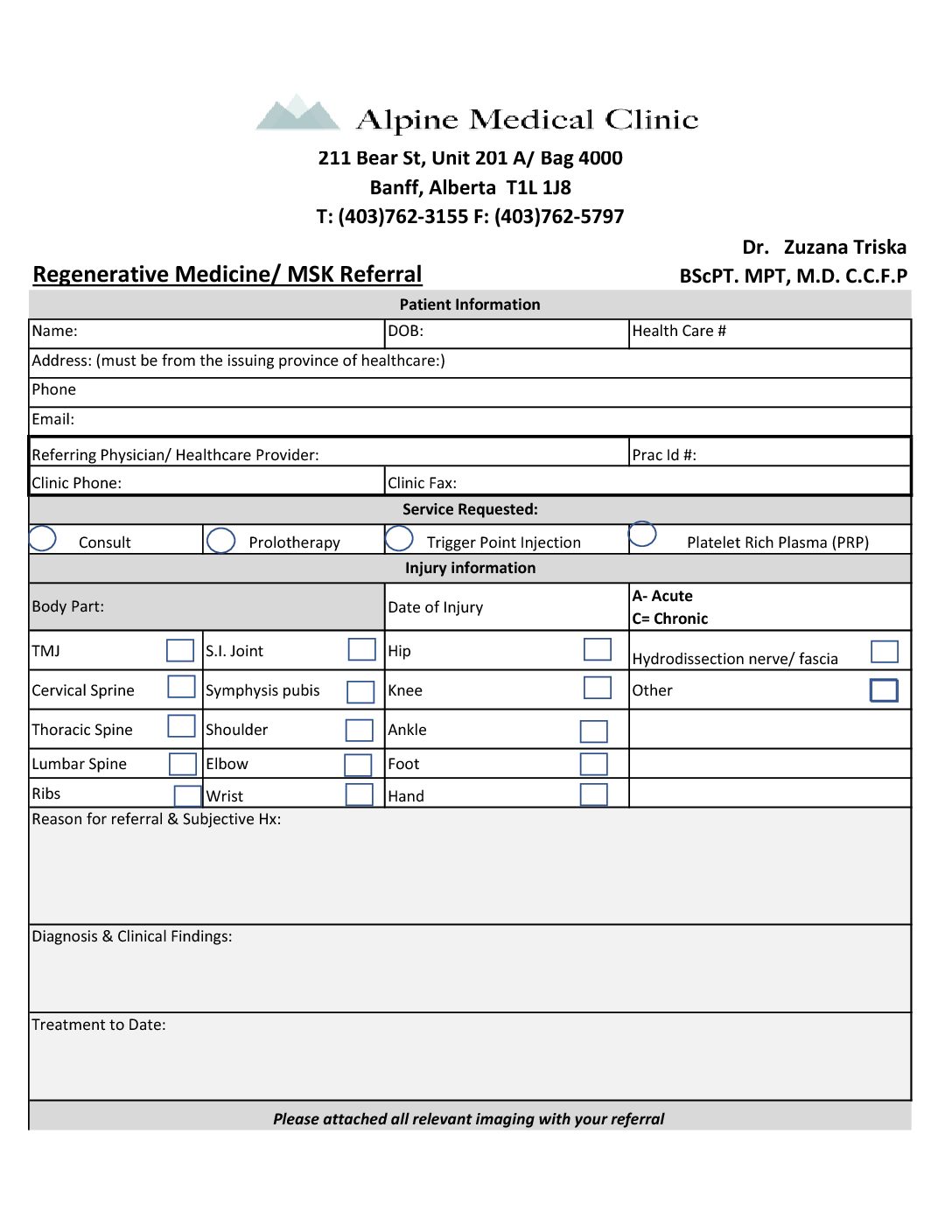


Platelet Rich Plasma (PRP) is blood plasma that has been enriched with platelets. These platelets have many different growth factors and cytokines which help to accelerate tissue healing and regeneration. Injections of PRP are often used to help trigger or enhance healing in tissues that have been injured, either abruptly or over-time (repetitive strain injuries), and have failed to heal on their own with adequate time and conservative treatment.
PRP injections can target ligaments, tendons, muscles as well as joints. There is good evidence that they are beneficial in speeding up recovery and improving pain and function in many conditions such as tennis elbow, knee osteoarthritis, rotator cuff injury, patellar tendon injury and plantar fasciitis. Research is ongoing, and clinical success has been demonstrated in treating a myriad of other soft tissue and joint conditions.
PRP is also being used effectively to treat certain types of hair loss and skin scarring, including acne scars.
PRP injections are similar to prolotherapy in some ways. The goal of both of these regenerative injections is to provide a healing stimulus to the injured tissue. PRP can do this in a more powerful way in some types of injuries. This means that fewer treatments are often needed, but the recovery period following treatment may involve a bit more discomfort and a need for rest.
The general process involves collecting the patient’s blood (just like a blood test), concentrating the blood platelets using a centrifuge and a special preparation kit and then injecting the concentrated sample back to the site of injury. The injection procedure is completed using ultrasound guidance to ensure delivery of PRP to the exact right locations.
Is the procedure painful?
The injections do cause some discomfort. Most people will feel stiff for a 24-48 hours.
Discomfort can be managed with Tylenol and/or Robaxacet. ADVIL/IBUPROFEN/ MOTRIN, ASPRIN/ASA, and CELEBREX should not be used if possible, as they can interfere with the initial steps of the healing process.
How many treatments will I need?
While some patients may only require one treatment, others may require up to three.
Treatments are completed approximately 4-6 weeks apart. For optimal results, patients are encouraged to continue with physiotherapy over the course of their treatments.
Are there any risks?
Complications from injecting extremity joints are extremely rare. These include skin infections and allergic reactions.
While extremely rare, complications from injections into the upper spine can include entry into the spinal canal and the possibility of puncturing the lung. The use of ultrasound to guide each injection significantly reduces the risk of any complications.
Your Appointment
Your first appointment will be a consultation with Dr. Triska to determine if you are a good candidate for PRP treatment. She will provide an in-depth assessment including a thorough history, review of any previous treatments and imaging studies, as well as a detailed physical exam. Injections are not done during this visit, but if PRP is deemed to be the most appropriate treatment option you will be given specific instructions about the treatment and will be rebooked for an injection appointment. For your injection appointment plan to be in the clinic for 30-60 minutes.
Is there a the cost?
PRP is not covered by Alberta Health. However, some private insurance plans may cover the cost. Cost varies depending on the body site. Please inquire with the physician directly about the cost.
What should I wear?
You will need to disrobe sufficiently to expose the area requiring treatment. Please plan ahead.
Level of Activity following treatment
Your level of activity will be dependent on your pre-existing condition and the location and intensity of the treatment. As a general rule, you can expect a period of relative rest for 1-2 weeks, followed by a gradual increase in your activity level. Dr. Triska or your physiotherapist will help provide guidance. You will have several follow-up visits to ensure the process is going smoothly.
For more information please visit www.prolotherapy.com or ask Dr. Triska directly
Prolotherapy, or proliferative therapy, is the injection of a solution (dextrose, saline, anaesthetic) to stimulate the growth of new cells to heal painful areas. Ligaments, joint capsules, tendons and muscle attachments can all be treated.
Ligaments are one of the primary targets. They surround all of our joints and have a large number of pain fibers, so if they are over-stretched or torn they cause pain. They can be injured by trauma (eg. ankle sprain, back sprain, whiplash) or become slack just from the passage of time with repetitive movements and postures. Common condition that respond well to prolotherapy treatment include arthritic joints (except severe arthritis), mechanical neck and back pain, SIJ dysfunction, TMJ dysfunction, mechanical shoulder pain, tennis elbow, and wrist and small joint laxity. This list is not exhaustive.
Who benefits from prolotherapy?
To determine probable benefit it is important that a trained clinician performs an assessment, as conservative therapies should be considered first. The more information we have when you visit, the better judgment we can make about your treatment. In general, prolotherapy often benefits those who have recurrent mechanical pain in a joint, tendon or at the site of a muscle attachment. Good candidates often find that they get only temporary relief from conservative treatments such as joint manipulation, active release/massage therapy, or dry needling (IMS).
The injections consist of a mixture of a local anaesthetic and Dextrose. The Dextrose solution acts as a mild irritant to the injected tissue. This stimulates mild inflammation, which in turn triggers a tissue healing cascade effect.
The most common risks when puncturing skin with any kind of needle are infection and bleeding. These are very rare due to the small diameter of the needle used and diligent cleansing of the skin.
With spinal injections it is possible to enter the spinal canal, but this is very rare, as injections directly over the middle of the spine are no longer used. If this happens, it may result in an intense headache for 2 – 4 days when upright. Laying flat alleviates the headache.
The other risk of consequence is the possibility of puncturing a lung, when injecting the upper part of your back. This is very rare, especially with the use of ultrasound guidance.
Allergic reactions are always a possibility with any new treatment, however, serious allergies to anaesthetic or dextrose ( a corn or sugar product) are thankfully very rare. If you think you may have an allergy to these substances, or know of a family member who had a serious allergic reaction to freezing or anaesthesia please let your doctor know.
Some people have expressed a concern about becoming too tight after the injections. This is not possible.
The injections are uncomfortable, but the local anaesthetic removes the pain quickly. If you require many injections, splitting treatments into two separate sessions may be helpful.
Most patients are able to drive themselves to and from the treatment and are able to return to work afterwards.
Most people will feel stiff for a day or two afterwards. Changing position regularly, gentle activity, gentle stretching, and heat are all that is usually required. If you are too stiff a muscle relaxant such as Robaxacet or pain medication such as Tylenol can be used. Please do not use anti-inflammatory painkillers for at least 7 days after and 2 days prior to your injections (Advil, Ibuprofen, ASA, Celebrex etc).
Most men require three to six sessions. Women usually require six to nine sessions as they are inherently more flexible. Treatments are usually done 2 -3 weeks apart. You can expect to see improvement from the injections one to two months after the last injection. Each session usually consists of between 4-20 injections, depending on the body part(s) being treated.
If you have access to a physiotherapist it is a good idea to see them 2-7 days after your injections. This is to check joint mobility and settle any muscle spasm. Physiotherapy is also important one to two months after the last injection when the ligaments are tightening to ensure your body is healing in an optimal position and that the muscle strength component hasn’t been forgotten about.
Is there a cost?
At present Alberta Health Care does not cover the cost of prolotherapy. Please contact the office for the current fee schedule. The fee varies depending on the number and complexity of areas treated. The fee will cover the cost of the procedure and materials used. Insurance plans vary, but as evidence and clinical success increases, more and more insurance companies will reimburse for the treatment. Payment must be made at each visit and we are unable to direct bill your insurance company or WCB. Please inquire with our staff or doctors about the current fee schedule.
Other Considerations
Stay as active as possible without aggravating your condition. Break up activities that bother you into shorter sessions e.g. clean one room at a time instead of doing the whole house at once. Walking every day is usually safe. For those who cannot tolerate walking, swimming or low impact activity such as cycling is a good way to stay active without irritating your symptoms.
Anti-inflammatory medications will block some of the benefits of prolotherapy, so avoiding them for 2 days prior and 7 days after treatment is essential (14 days is even better). Tylenol, muscle relaxants and most other prescriptions for other health conditions can be continued. If you are unsure about using a medication, please ask your doctor.
Stress or other stimulants such as cold medications can cause muscle tightening. Try to avoid these or consider relaxation training for stress.
Please have your referring health care provider (doctor or physiotherapist) send a referral to us for a Prolotherapy Assessment. If you do not have a doctor or therapist, you may request to book directly with Dr. Triska. Make sure you indicate that the purpose of your appointment is for a Prolotherapy Assessment.
The first appointment usually does not include injections, instead, time is spent reviewing your condition in-depth to determine if you would be a good candidate for prolotherapy, or if other types of treatment may be more appropriate. If you have had x-rays, MRIs or other imaging, please try to bring copies of these reports to your appointment. There is a fee for not attending your scheduled appointment, or cancellation with less than 24 hrs prior notice.
You should wear loose-fitting clothing that allows easy access to the affected area. This will also be more comfortable afterwards. There is often some pinpoint bleeding after the injections which could stain your clothes, so please plan ahead.
For additional sources of information, see www.prolotherapy.com or speak directly with Dr. Triska.
What are trigger point injections?
Trigger point injections are small amounts of anaesthetic (freezing) injected into tight motor points (or “knots”) in your muscles, using a very thin needle.
How do they work?
The way they work is two-fold. The simple act of inserting a needle into a tight motor point causes the muscle to contract/twitch suddenly, which then triggers a reflexive muscle relaxation. The anaesthetic works to make sure that the muscle doesn’t tighten up again right away. Some patients get temporary relief of a few days to a few weeks, while others get long-lasting relief just from a few sessions. If relief is significant but only temporary this is usually an indication that a deeper problem is an ongoing trigger for the muscle tightness. The deeper problems might be due to ligament laxity, joint inflammation/arthritis, tendon injury or faulty biomechanics. Dr. Triska can assist with identifying the likley underlying reasons for ongoing pain and recommend other treatment options.
Who is a good candidate for trigger point injections?
It’s surprising how many people benefit from these injections. Pretty much any tight muscle in the body can be injected (with a few exceptions). Those who have pain from tight muscles and get temporary benefit from massage therapy, stretching or dry needling (IMS, certain types of acupuncture) but are looking for longer-lasting benefits are generally good candidates. Also, people who have pain from tight muscles, but cannot afford to pay for hands-on therapies like massage/physiotherapy may find trigger point injections helpful, as they are covered by AHS healthcare.

